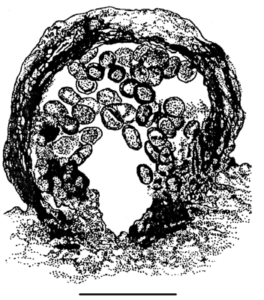Fungalpedia – Note 192 Diplodites (Fossil Fungi)
Diplodites Teterevn.-Babajan & Tasl. ex Kalgutkar, Nambudiri & Tidwell
Citation when using this data: Saxena RK & Hyde KD. 2024 (in prep) – Fungalpedia, Fossil Fungi.
Index Fungorum, Facesoffungi, MycoBank, GenBank, Fig. 1
Classification: Botryosphaeriaceae, Botryosphaeriales, Dothideomycetes, Pezizomycotina, Fossil Ascomycota, Fungi.
Kalgutkar et al. (1993) described the monotypic fossil genus, Diplodites, from the Deccan Intertrappean beds (Late Cretaceous, Maastrichtian, 72–66 mya) of Mohgaon Kalan, Chhindwara District, Madhya Pradesh, India. This genus is characterized by septate, branched, smooth, thick-walled, intercellular hyphae in the pericarp. It is thick-walled with pseudoparenchymatous tissue, generally ostiolate, and astomous when immersed, solitary or aggregated in small groups and with subicle or stroma. Stroma are typically dark brown or black, composed of thick-walled cells, uniloculate. Conidia are 1-septate or aseptate, both kinds occurring in the same pycnidium, light to dark brown, with septa twice as thick as spore walls. One-celled conidia are lightly coloured; two-celled conidia are brown, with striations occasionally present. Conidiophores or their remnants not present. Pycnidia are superficial or immersed, with no definite orientation and variable shape (globose to subglobose, ovate-oblong or pyriform) and size. Immature pycnidia are filled with thin-walled cells. The name of the genus indicates its proximity to extant Diplodia Fr. There are two records in Index Fungorum (2023) under this genus.
Synonym: Palaeodiplodites Watanabe, Nishida & Kobayasi.
Type species: Diplodites sweetii Kalgutkar, Nambudiri & Tidwell.
Figure 1 – Diplodites sweetii. Scale bar = 30 μm. Redrawn from Kalgutkar et al. (1993).
References
Entry by
Ramesh K. Saxena, Birbal Sahni Institute of Palaeosciences, Lucknow, India
(Edited by Kevin D. Hyde, Samaneh Chaharmiri-Dokhaharani, & Achala R. Rathnayaka)
Published online 31 January 2024
